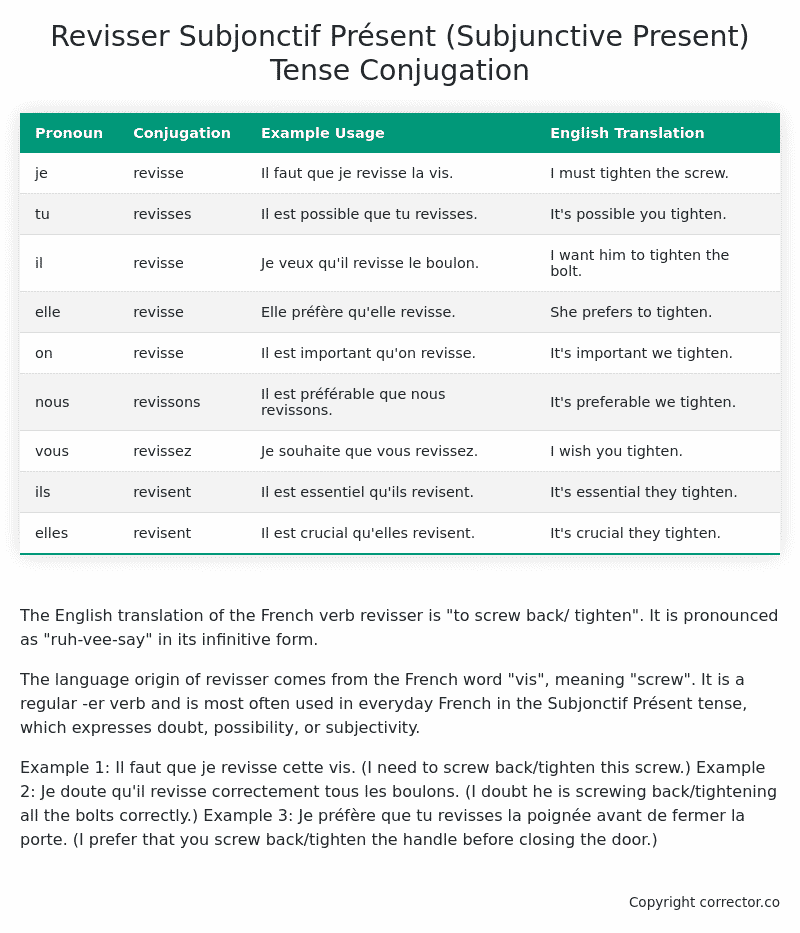Subjonctif Présent (Subjunctive Present) Tense Conjugation of the French Verb revisser
Introduction to the verb revisser
The English translation of the French verb revisser is “to screw back/ tighten”. It is pronounced as “ruh-vee-say” in its infinitive form.
The language origin of revisser comes from the French word “vis”, meaning “screw”. It is a regular -er verb and is most often used in everyday French in the Subjonctif Présent tense, which expresses doubt, possibility, or subjectivity.
Example 1: Il faut que je revisse cette vis. (I need to screw back/tighten this screw.)
Example 2: Je doute qu’il revisse correctement tous les boulons. (I doubt he is screwing back/tightening all the bolts correctly.)
Example 3: Je préfère que tu revisses la poignée avant de fermer la porte. (I prefer that you screw back/tighten the handle before closing the door.)
Table of the Subjonctif Présent (Subjunctive Present) Tense Conjugation of revisser
| Pronoun | Conjugation | Example Usage | English Translation |
|---|---|---|---|
| je | revisse | Il faut que je revisse la vis. | I must tighten the screw. |
| tu | revisses | Il est possible que tu revisses. | It’s possible you tighten. |
| il | revisse | Je veux qu’il revisse le boulon. | I want him to tighten the bolt. |
| elle | revisse | Elle préfère qu’elle revisse. | She prefers to tighten. |
| on | revisse | Il est important qu’on revisse. | It’s important we tighten. |
| nous | revissons | Il est préférable que nous revissons. | It’s preferable we tighten. |
| vous | revissez | Je souhaite que vous revissez. | I wish you tighten. |
| ils | revisent | Il est essentiel qu’ils revisent. | It’s essential they tighten. |
| elles | revisent | Il est crucial qu’elles revisent. | It’s crucial they tighten. |
Other Conjugations for Revisser.
Le Present (Present Tense) Conjugation of the French Verb revisser
Imparfait (Imperfect) Tense Conjugation of the French Verb revisser
Passé Simple (Simple Past) Tense Conjugation of the French Verb revisser
Passé Composé (Present Perfect) Tense Conjugation of the French Verb revisser
Futur Simple (Simple Future) Tense Conjugation of the French Verb revisser
Futur Proche (Near Future) Tense Conjugation of the French Verb revisser
Plus-que-parfait (Pluperfect) Tense Conjugation of the French Verb revisser
Passé Antérieur (Past Anterior) Tense Conjugation of the French Verb revisser
Futur Antérieur (Future Anterior) Tense Conjugation of the French Verb revisser
Subjonctif Présent (Subjunctive Present) Tense Conjugation of the French Verb revisser (this article)
Subjonctif Passé (Subjunctive Past) Tense Conjugation of the French Verb revisser
Subjonctif Imparfait (Subjunctive Imperfect) Tense Conjugation of the French Verb revisser
Subjonctif Plus-que-parfait (Subjunctive Pluperfect) Tense Conjugation of the French Verb revisser
Conditionnel Présent (Conditional Present) Tense Conjugation of the French Verb revisser
Conditionnel Passé (Conditional Past) Tense Conjugation of the French Verb revisser
L’impératif Présent (Imperative Present) Tense Conjugation of the French Verb revisser
L’infinitif Présent (Infinitive Present) Tense Conjugation of the French Verb revisser
Struggling with French verbs or the language in general? Why not use our free French Grammar Checker – no registration required!
Get a FREE Download Study Sheet of this Conjugation 🔥
Simply right click the image below, click “save image” and get your free reference for the revisser Subjonctif Présent tense conjugation!

Revisser – About the French Subjonctif Présent (Subjunctive Present) Tense
Formation of the Subjonctif Présent
Common Everyday Usage Patterns
Interactions with Other Tenses
Summary
I hope you enjoyed this article on the verb revisser. Still in a learning mood? Check out another TOTALLY random French verb conjugation!


